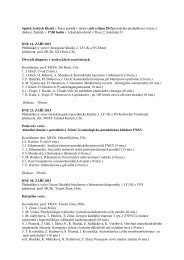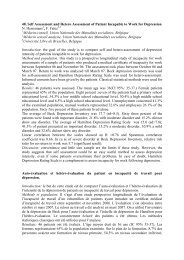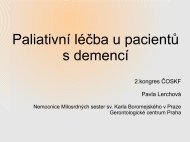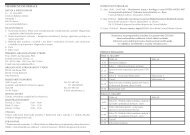ABSTRACTS â ORAL PRESENTATIONS - AMCA, spol. s r.o.
ABSTRACTS â ORAL PRESENTATIONS - AMCA, spol. s r.o.
ABSTRACTS â ORAL PRESENTATIONS - AMCA, spol. s r.o.
Create successful ePaper yourself
Turn your PDF publications into a flip-book with our unique Google optimized e-Paper software.
et al. 2006), we speculate that defects in interferon induced plasma cell differentiation<br />
is defective in cluster_5 patients. Biological consequences of these genomic alterations<br />
are currently being investigated.<br />
The results demonstrate the usefulness of standardised flow cytometry profiling of large<br />
group of patients samples.<br />
Acknowledgements<br />
This work was supported by IGA NT/11414-5, IGA NT/13271, P302/12/G101, UNCE<br />
204012, 00064203.<br />
References<br />
Asokan et. al. Characterization of Human Complement Receptor Type 2 (CR2/CD21) as<br />
a Receptor for IFN-α: A Potential Role in Systemic Lupus Erythematosus, The Journal of<br />
Immunology vol. 177 no. 1 383-394, July 1, 2006<br />
37. EFFECT OF GENETIC RISK FACTORS ON IMMUNE CELL PHENOTYPES IN PATIENTS<br />
WITH RHEUMATOID ARTHRITIS<br />
L. Chovanova 1,2 , M. Vlcek 1,2 , K. Krskova 1 , F. Spoutil 3 , J. Rovensky 4 , R. Brownlie 5 ,<br />
R. Zamoyska 5 , R. Imrich 1,2<br />
1<br />
Institute of Experimental Endocrinology; lucia.chovanova@savba.sk<br />
2<br />
Center for Molecular Medicine, Slovak Academy of Sciences;<br />
3<br />
Institute of Experimental Medicine, Academy of Sciences, Prague, Czech Republic;<br />
4<br />
National Institute of Rheumatic Diseases, Piestany, Slovak Republic<br />
5<br />
Institute of Immunology and Infection Research, University of Edinburgh, Edinburgh,<br />
United Kingdom<br />
The involvement of genetics, environment and autoimmunity in the pathogenesis of<br />
rheumatoid arthritis (RA) has been proposed recently. The most important genetic factor<br />
is the shared epitope (SE) sequence in HLA-DRB1 molecule, followed by more than 30<br />
variants in potentially pathogenic non-MHC genes. The knowledge about their actual<br />
effect on immune cell function and related mechanisms is relatively poor.<br />
The aim of our study was to obtain a broader picture of relations between circulating<br />
immune cell phenotype, cytokine production after stimulation and the genetic<br />
background.<br />
PBMC were isolated from 35 healthy individuals and 36 RA patients with known genotype<br />
in the genes: PTPN22, STAT4, CTLA4, PADI4, AFF3, IRF5, TRAF1/C5 and HLA-DRB1. The<br />
proportions of selected PBMC subsets were analysed by flow cytometry. TNF-α, IFN-γ<br />
and IL-17 production was assessed after stimulation with PMA/ionomycin. Redundancy<br />
analysis (RDA) was applied to analyse the data.<br />
RDA analysis showed that higher proportions of memory B cells and TCRγδ cells were<br />
associated with the presence of risk allele in PTPN22 and AFF3. Risk alleles in IRF5, STAT4<br />
and TRAF1/C5 genes were associated with increased production of TNF-α and IFN-γ by<br />
NKT cells regardless of the diagnosis.<br />
Alterations in immune cell proportions and cytokine secretion are suggested as the<br />
Analytical Cytometry VII 57








